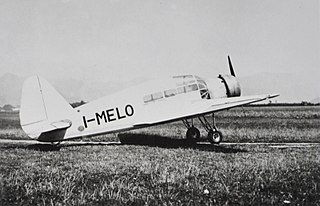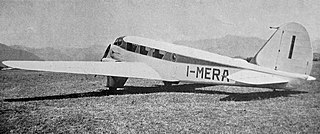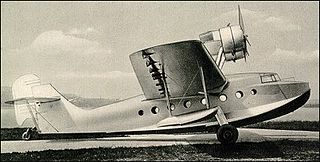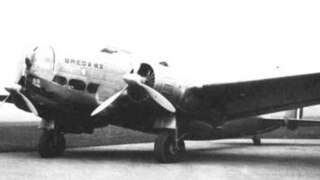| CANT Z.509 | |
|---|---|
 | |
| Role | Mail plane |
| Manufacturer | CANT |
| First flight | 1937 |
| Introduction | 1937 |
| Primary user | Ala Littoria |
| Number built | 3 |
The CANT Z.509 was a three-engine Italian floatplane developed from the Z.506A for use as a mailplane.
| CANT Z.509 | |
|---|---|
 | |
| Role | Mail plane |
| Manufacturer | CANT |
| First flight | 1937 |
| Introduction | 1937 |
| Primary user | Ala Littoria |
| Number built | 3 |
The CANT Z.509 was a three-engine Italian floatplane developed from the Z.506A for use as a mailplane.
Designed as a larger and heavier version of the Z.506A, three aircraft were built in 1937 for Ala Littoria . The aircraft were for use on the airline's transatlantic postal service to South America. The aircraft was a twin-float seaplane powered by three Fiat A.80 R.C.41 radial engines. With the outbreak of World War II, development of the type was abandoned.
Data from [1]
General characteristics
Performance
Aircraft of comparable role, configuration, and era
Related lists

The CANT Z.506 Airone was a triple-engine floatplane produced by CANT from 1935. It served as a transport and postal aircraft with the Italian airline "Ala Littoria". It established 10 world records in 1936 and another 10 in 1937. During World War II it was used as a reconnaissance aircraft, bomber and air-sea rescue plane, by the Italian Regia Aeronautica and Regia Marina, Aeronautica Cobelligerante del Sud, Aeronautica Nazionale Repubblicana and the Luftwaffe. The military version revealed itself to be one of the best floatplanes ever built. Despite its wooden structure it was able to operate in very rough seas. A number of Z.506S air-sea rescue aircraft remained in service until 1959.

The Savoia-Marchetti S.74 was a four-engine airliner developed by Savoia-Marchetti for Ala Littoria.

The CANT Z.511 was a four-engine long-range seaplane designed by Filippo Zappata of the "Cantieri Riuniti dell'Adriatico" (CRDA) company. Originally designed for the Central and South Atlantic passenger routes, it was later adapted as a military transport and special raider.

The Ambrosini SAI.3 was a two-seat Italian touring airplane first flown in 1937. It was a low-wing monoplane with a graceful, elliptical wing, and fixed tailwheel undercarriage. Customers could choose between enclosed or open cockpits, and between an inline Alfa Romeo 115 engine or a radial Fiat A.50. A revised version was marketed as the SAI.3S with a smaller-chord wing and a Siemens-Halske Sh 14 radial engine, this offering far superior performance to the original SAI.3 design.

The Breda Ba.25 was an Italian two-seat biplane trainer designed and built by the Breda company. It was the most widely used Italian basic trainer of the 1930s.

The Meridionali Ro.37 Lince was a two-seater Italian reconnaissance biplane, a product of the Industrie Meccaniche Aeronautiche Meridionali (IMAM) company. It appeared in 1934 and had a composite structure of wood and metal. The aeroplane first saw operational duty in the Second Italo-Ethiopian War (1935–1936) and Spanish Civil War (1936–1939), and during the Second World War it saw duty on almost all fronts, except for Russia and the English Channel. It followed the Ro.1 as the main reconnaissance aircraft for the Italian Army.

The Caproni PS.1, also known as the Pallavicino PS-1 and Caproni Ca.303, was an Italian four-seater sportsplane, designed and built specifically to compete in Challenge 1934, the European touring plane championships.

The Savoia-Marchetti SM.83 was an Italian civil airliner of the 1930s. It was a civilian version of the Savoia-Marchetti SM.79 bomber.

The Savoia-Marchetti S.84 was an Italian twin-engined airliner developed, in Italy, from the three-engined Savoia-Marchetti S.73; only the prototype was completed and the designation was re-used for the Savoia-Marchetti SM.84

The Breda Ba.39, a touring and liaison aircraft designed and built in Italy, was a scaled-up version of the Breda Ba.33, achieving some success in sporting events, and distance flights.

The IMAM Ro.51 was an Italian fighter aircraft that first flew in 1937. It was designed for the 1936 new fighter contest for the Regia Aeronautica, with practically all the Italian aircraft builders involved.

The Caproni Ca.308 Borea was a small airliner built in Italy in the mid-1930s.

The Macchi M.C.94 was a 1930s Italian commercial flying boat built by Macchi.
The Caproni-Campini Ca.183bis was an Italian projected high-altitude fighter intended to have both piston and jet propulsion.

The Caproni Vizzola F.4 was an Italian fighter aircraft prototype designed and built from 1939. It was a single-seat, low-wing cantilever monoplane with retractable landing gear.

The Piaggio P.111 was an Italian high-altitude research aircraft designed and built by Piaggio for the Regia Aeronautica.

The Macchi M.71 was an Italian flying boat fighter of the 1930s designed and manufactured by Macchi.

The Breda Ba.32 was an Italian airliner prototype designed and built by the Breda company.

The Breda Ba.82 was an Italian medium bomber prototype of the late 1930s; it was designed and built by the Breda company.

The CANT Z.505 was a prototype trimotor transport floatplane built by CANT in the 1930s.
| Wikimedia Commons has media related to CANT Z.509 . |